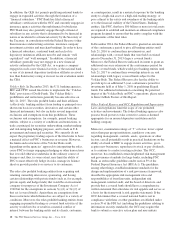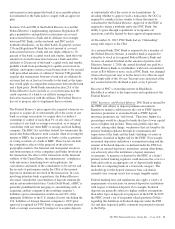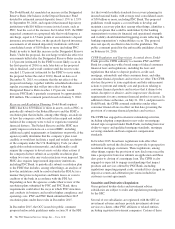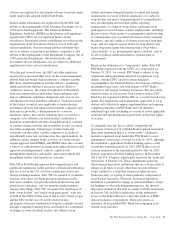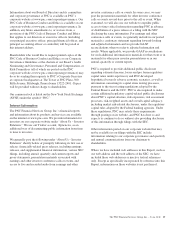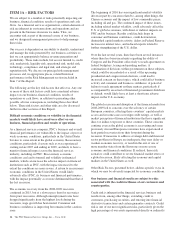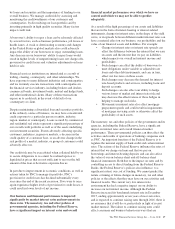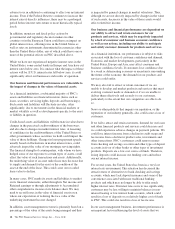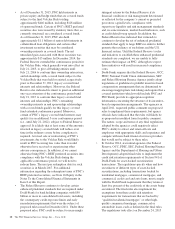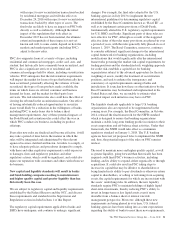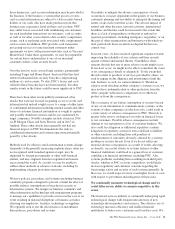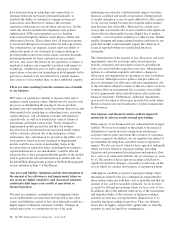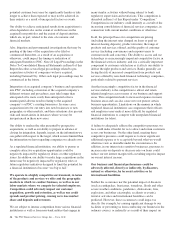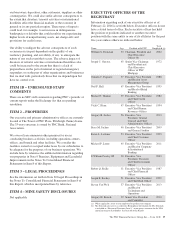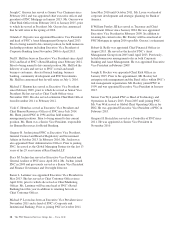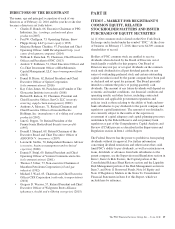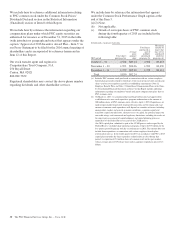PNC Bank 2015 Annual Report Download - page 38
Download and view the complete annual report
Please find page 38 of the 2015 PNC Bank annual report below. You can navigate through the pages in the report by either clicking on the pages listed below, or by using the keyword search tool below to find specific information within the annual report.• As of December 31, 2015, PNC held interests in
private equity and hedge funds that are covered funds
subject to the final Volcker Rule totaling
approximately $446 million, including $128 million
of sponsored funds. Certain of PNC’s REIT preferred
securities also were issued by statutory trusts that, as
currently structured, are considered covered funds.
As of December 31, 2015, PNC also held
approximately $1.1 billion of senior debt interests in
collateralized loan obligations and certain other
investment securities that may be considered
ownership interests in covered funds. The net
unrealized gain associated with these securities was
approximately $13 million. In December 2014, the
Federal Reserve extended the conformance period for
the Volcker Rule, which generally went into effect on
July 21, 2015, to give all banking entities until
July 21, 2016 to conform their ownership interests in,
and relationships with, covered funds subject to the
Volcker Rule that were held or existed, respectively,
prior to December 31, 2013 (legacy covered fund
interests and relationships). Moreover, the Federal
Reserve also indicated its intent to grant an additional
one-year extension of the conformance period until
July 21, 2017 to conform their legacy covered fund
interests and relationships. PNC’s remaining
ownership interests in and sponsorship relationships
with covered funds qualify for this legacy covered
fund extended conformance period. Moreover,
certain of PNC’s legacy covered fund interests may
qualify for an additional 5-year conformance period
(i.e., until July 21, 2022), subject to Federal Reserve
approval. It is likely that at least some of the amounts
invested in legacy covered funds will reduce over
time in the ordinary course before compliance is
required. A forced sale or restructuring of PNC’s
investments due to the Volcker Rule would likely
result in PNC receiving less value than it would
otherwise have received or experiencing other
adverse consequences. In addition, if we cannot
otherwise bring PNC’s REIT preferred securities into
compliance with the Volcker Rule during the
applicable conformance period, we will need to
redeem them. The next par redemption date for such
securities is in March 2017. For additional
information regarding the redemption terms of PNC’s
REIT preferred securities, see Note 16 Equity in the
Notes To the Consolidated Financial Statements in
Item 8 of this Report.
• The Federal Reserve continues to develop certain
enhanced prudential standards that are required under
Dodd-Frank for bank holding companies with $50
billion or more in consolidated total assets, including
the counterparty credit exposure limits and early
remediation requirements that were the subject of
proposed rules issued in December 2011. Under these
proposed rules, PNC could be subject to increasingly
stringent actions by the Federal Reserve if its
financial condition or risk management deteriorated
as reflected by the company’s current or projected
post-stress capital levels, compliance with
supervisory liquidity and risk management standards
and, in some instances, market-based indicators, such
as credit default swap spreads. In addition, the
Federal Reserve has indicated that it intends to
continue to develop the set of enhanced prudential
standards that apply to large BHCs in order to further
promote the resiliency of such firms and the U.S.
financial system. Until the Federal Reserve’s rules
and initiatives to establish these enhanced prudential
standards are completed, we are unable to fully
estimate their impact on PNC, although we expect
these initiatives will result in increased compliance
costs.
• Dodd-Frank requires that the Federal Reserve, OCC,
FDIC, National Credit Union Administration, SEC
and Federal Housing Finance Agency jointly adopt
regulations or guidelines to prohibit incentive-based
compensation arrangements that are determined to
encourage inappropriate risk-taking and require that a
covered institution (which would include PNC and
PNC Bank) provide its appropriate regulator
information concerning the structure of its incentive-
based compensation arrangements. The agencies in
April 2011, requested public comment on proposed
rules to implement these requirements, but agency
officials have indicated that the rules will likely be
re-proposed in modified form for public comment.
The nature, scope and terms of any final regulations
adopted by the agencies could negatively affect
PNC’s ability to attract and retain officers and
employees with appropriate skills and experience and
compete with non-bank financial services providers
that would not be subject to these rules.
• In October 2014, six federal agencies (the Federal
Reserve, OCC, FDIC, SEC, Federal Housing Finance
Agency and the Department of Housing and Urban
Development) adopted final rules to implement the
credit risk retention requirements of Section 941 of
Dodd-Frank for asset-backed securitization
transactions. The regulations specify when and how
securitizers of different types of asset-backed
securitizations, including transactions backed by
residential mortgages, commercial mortgages, and
commercial, credit card and auto loans, must comply
with the Dodd-Frank requirement that they retain at
least five percent of the credit risk of the assets being
securitized. The final rules also implement the
exemptions from these credit risk retention
requirements for transactions that are backed by
“qualified residential mortgages” or other high-
quality commercial mortgage, commercial or
automobile loans, each as defined in the final rules.
The regulations took effect on December 24, 2015
20 The PNC Financial Services Group, Inc. – Form 10-K


